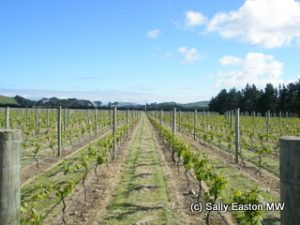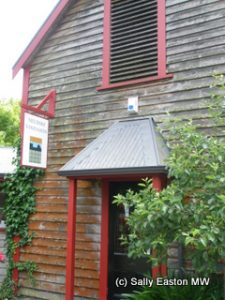Pinot noir regionality develops in New Zealand

Martinborough
Notwithstanding that most pinot noir vines in New Zealand are less than ten years old, the idea of differing regional expressions of the variety has already been gaining ground for at least half of that time.
A ten-wine ‘road-trip’ in London, led by Dr. John Forrest of Forrest Wines, explored this theme, inconclusively to my palate, though different expressions in the wines were clear to see.
Not all pinot noir vines in New Zealand are infants. There are plenty that are a quarter of a century and more. But that plantings of pinot noir have increased by more than 80% since 2003 illustrates the burgeoning interest in Kiwi pinot noir, arguably the second-best place in the world that makes it. And Forrest is excited for the future coming from maturing vines, saying “tannins are yet to be defined. We’re talking of 30 year old vines, at the oldest. Tannin structure is where, over the next 15 years, New Zealand pinot noir will flourish – structure and texture.”
In the meantime, any emergence of regional styles is akin to evolution in practice.
The regions considered at this tasting were: Wairarapa/Martinborough, Nelson, Marlborough, Canterbury and Central Otago, with newest region Waitaki, on the east coast also making an appearance.
Forrest explained differences in soil types, where older, stonier soils, within the NZ context, are preferred because they have a deeper top layer with a proportion of clay that helps regulate water supply. He said “terroirs are variable, which is great. You get a variety of wines. Soils are dominated by river gravels, and the best pinot noir sites combine some geological age with secondary characters, such as clay and limestone, mixed in with the gravel.”
He added “the simplest pinot noirs in New Zealand come off straight stones – fruity tutti straight pinot noir. You need older soils for complexity and tertiary flavours. The south part of Marlborough has half million year old soils.”
Climatically all the favoured pinot noir regions are below latitude 41, and as you go further south, Forrest said “you get cooler nights and a shorter growing season. And flavour development is determined by the diurnal temperature variation” where the cool nights help develop flavour in the fruit. He added “it’s this cool climate touch to the fruit that New Zealand does so well. A fresh, bright, acid structure is a feature of New Zealand wine.”

Nelson
It is the cooler South Island that is the mainstay of Kiwi pinot noir, with just the original, Wairarapa, including Martinborough, region, being at the bottom of North Island. There are some 500 miles between Martinborough and the most southerly region, Central Otago, so one might expect some regional variation. Compare Burgundy’s Côte d’Or which is around 30 miles from top to bottom.
It would be logical to expect fuller, slightly warmer, suppler stylistic expression towards the north and crisper, crunchier things going on further south.
A special Central Otagan terroiristic expression, said Forrest “is an element of wild thyme. The vineyards are surrounded by it, and it gives a wild thyme terroir character.”
Winemaking influences still play an important role in style, and a general theme, said Forrest is that “over the last 20 years we’ve gone through a phase of getting it riper and riper and riper. Now the pinot noir pendulum is moving back from the 14 – 15% alcohol fruit bomb. We’re just swinging back to 13.5%, with more delicacy and ‘pinosity’.”
The use of a lot of stems in the ferment is not common though. Forrest said “it is not the norm to put a lot of stems in a New Zealand pinot noir ferment. We have greener stems that are still physiologically ripening.” The tannin structure is harsher in stems, so, he added “you must stand and chew it on the day it arrives and decide then whether to use it.”
I did conclude that New Zealand makes some really lovely pinot noirs (I’d concluded that long before). Regional expressions are sure to emerge given a bit of history. Viticulture has never really done the ‘I want it now’ zeitgeist. How many centuries did it take for Burgundian differences to be widely recognisable?
Tasting notes, London, January 2012, north to south
Gladstone Vineyard, Pinot Noir 2009, Wairarapa
Alluvial gravelly soils of mixed geological age. Medium pale ruby colour, sweet plum and redcurrant fruit, aromatic. Sweet, soft, supple, silky texture, with smooth definition and integrity. The warmth of alcohol is noticeable, otherwise it’s focused, defined and succulent. Good.
Palliser Estate, Pinot Noir 2009, Martinborough
Alluvial soils. Medium ruby colour. Smells a hint ‘stalky’, certainly herbal, with dark plum fruit and aromatic tar, almost bramble. Lush sweet fruit alongside, with a bit of grip and angular backbone.
Neudorf Vineyards, Moutere Pinot Noir 2009, Nelson
Clay vineyard. Medium ruby colour. Graphite and soft plum on nose, bright lift to palate attack and sweet, ripe fruit, with the restraint of taut graphite – a firming backbone amid real complexity and class. Vg.
Nautilus Estate, Pinot Noir 2009, Marlborough
Blend of river gravels and older clay sites. Nose not hugely forward, then sweet red cherry fruit in straightforward, juicy style without real gravitas. Has silky fresh, texture, with all brightness and enthusiasm of a teenager. Long finish counters earlier comment about gravitas. Nice wine.
Fromm Winery, Clayvin Vineyard Pinot Noir 2009, Marlborough
Geologically old, crushed gravels with high clay content. Medium ruby, muted gravelly, graphite nose. Backbone, graft and structure here amid ripe fruit, dark plum, dark cherries, all very serious and quite sophisticated. Savoury and stylish.
Pegasus Bay, Pinot Noir 2009, Waipara
Bright red cherry, with tarry aromatics and savoury, almost dry earthy core. Warm alcohol, as a positive attribute, with silky smooth, fine-grained tannin texture, and savoury finish.
Muddy Water, Slowhand Pinot Noir 2009, Waipara
Quite deep ruby colour. Nose is not very expressive, and the palate is full bodied, with sweet-ripe fruit, fresh red cherries in a dry-succulent sort of way. This is a BIG wine, with some heat of alcohol at the end (over 14%). For me the least varietally-defined wine of the tasting.
John Forrest, Collection Pinot Noir 2009, Waitaki
Limestone-infused terraces. Perfumed red cherry and wild raspberry fruits. Seductive attack, sweet and with some chalky freshness of backbone, succulent, and showing good refinement. Long finish. Very nice.
Akarua, Pinot Noir 2010, Central Otago
Deep ruby colour. Bright sweet plum and redcurrant fruits. Fresh, young (shame it’s a different vintage), crunchy and brightly balanced. Hints of oak still integrating well. Crunchily balanced with big concentration. And good length.
Peregrine, Pinot Noir 2009, Central otago
Aromatic smoky, graphite notes on the nose. Silky, bright palate attack. Linear, smooth and fresh balance to the backbone. Integrity and substance in a medium-bodied wine that has lovely concentration and depth. Vg.
Comments
2 Responses to “Pinot noir regionality develops in New Zealand”




March 14, 2012 at 8:54 pm
Hi Sally,
Nice article and I am glad you enjoyed the wines. Re John’s comment that tannin structure and texture is expected to flourish over the next 15 years I expect this is where a whole bunch component will play an increasing part. A number of Marlborough pinot makers are ‘flirting’ with stem use and are finding it much more appropriate now than a few years ago. Increasing vine age is the key here we are finding fruit/stem tannin now playing a much more important part in structure whereas vines off young vineyards tended to be propped up with oak tannin.
Cheers,
Clive
March 15, 2012 at 9:54 am
Thanks Clive. I’ve long (relatively!) been a fan of kiwi pinot noir, and I’m beginning to get to grips (any possible pun intended) with whole bunches and stems. Does this mean carbonic maceration is coming of age?